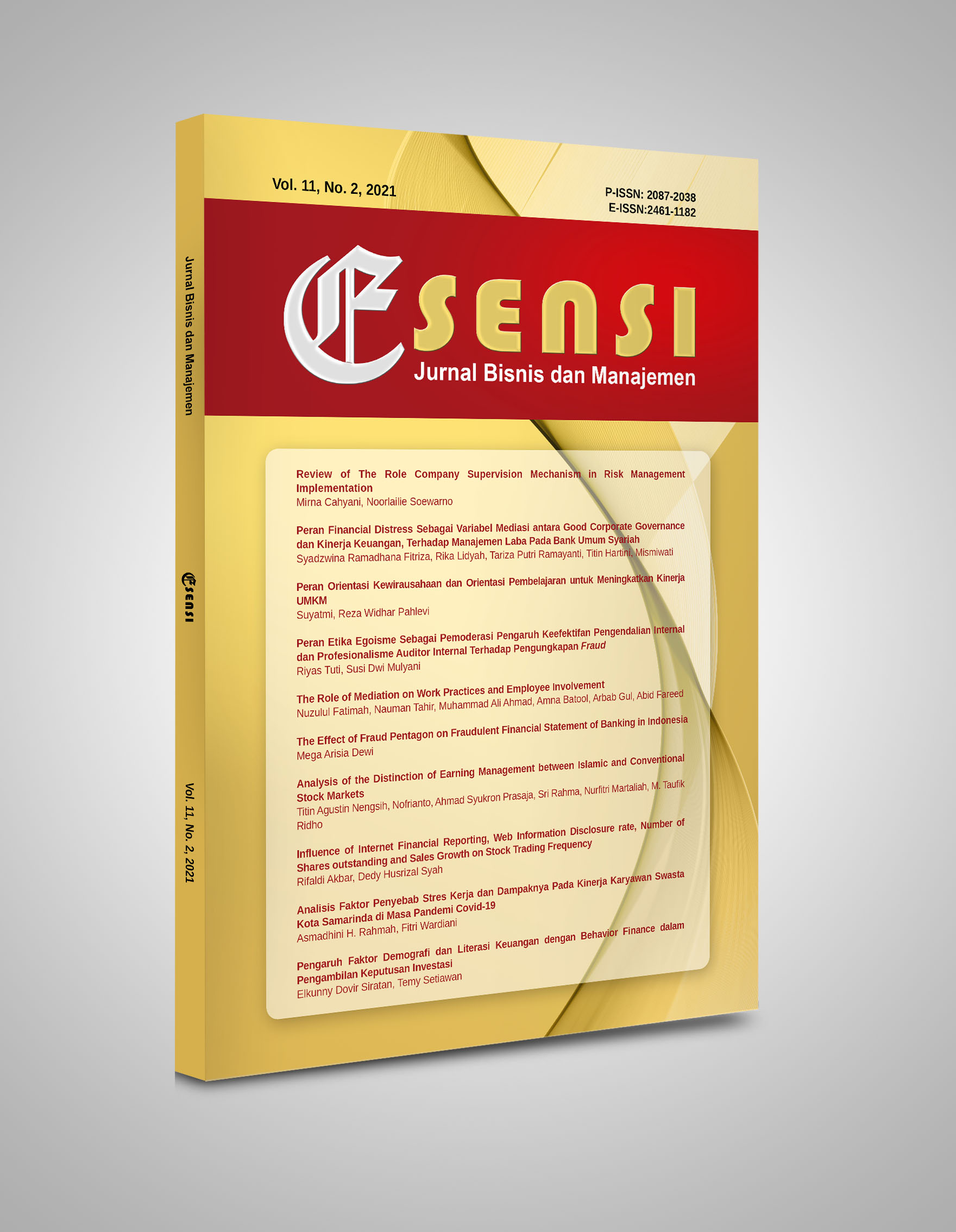The Role of Mediation on Work Practices and Employee Involvement
DOI:
https://doi.org/10.15408/ess.v11i2.20389Keywords:
High-involvement work practices, Employee Engagement, Job satisfactionAbstract
Organizations face many challenges regarding employee engagement and employee job satisfaction. To increase the level of employee job satisfaction, HIWP must be implemented in order to have an impact on employee performance satisfaction. The purpose of this study was to examine the relationship between high-involvement work practices (HIWP) and job satisfaction with the mediating effect of employee engagement; HIWPs consist of four main attributes: (a) power (b) information (c) reward (d) knowledge. This study investigates the relationship between the three variables. Here, convenience sampling was used and data were collected through questionnaires from 185 organizational respondents in the banking sector. Regression analysis was used to test the hypothesis and Andrew F. Hayes model 4 was used to examine the mediating effect. The results showed that there was a significant relationship between the mediating variables and the effect of employee engagement. This study expands on HIWP employment and job satisfaction. The practical implication of this research is to measure the level of job satisfaction of employees by using HIWP can be implemented for managers and employees.
References
BinBakr, M. B., & Ahmed, E. I. (2018). High-involvement work processes and organizational commitment of female faculty in Saudi Arabia. International Journal of Leadership in Education.
Christian, M. S., Garza, A. S., & Slaughter, J. E. (2011). Work engagement: A quantitative review and test of its relations with task and contextual performance. Personnel Psychology, 64(1), 89–136.
Crawford, E. R., Rich, B. L., Buckman, B., & Bergeron, J. (2014). Employee engagement in theory and practice. New York, NY: Routledge.
Emmywati, E., Sukatmadiredja, N. R., & Wibowo, B. S. (2020). JOB CRAFTING, WORK ENGAGEMENT AND SUSTAINABLE FOR EMPLOYEE PERFORMANCE IN DIRECTORATE OF TELECOMMUNICATIONS DIRECTORAT GENERAL OF POSTAL AND INFORMATICS IMPLEMENTATION IN JAKARTA. Media Mahardhika, 18(2), 179–191.
Fataro Bernike, Z. (2015). Analisis Pengaruh Lingkungan Kerja dan Motivasi Kerja Terhadap Kepuasan Kerja Karyawan PT. Fastfood Indonesia, Tbk Kantor Perwakilan.
Hakim, M. L. (n.d.). Archive for May, 2020.
Ho, A. S., Sarti, E. E., Jain, K. S., Wang, H., Nixon, I. J., Shaha, A. R., Shah, J. P., Kraus, D. H., Ghossein, R., & Fish, S. A. (2014). Malignancy rate in thyroid nodules classified as Bethesda category III (AUS/FLUS). Thyroid, 24(5), 832–839.
Iddagoda, Y. A., & Opatha, H. (2017). Identified research gaps in employee engagement. International Business Research, 10(2), 63–73.
Lowe Jr, J. M. (2021). One Team, One Fight: the Role of Empowerment in the US Navy. Trident University International.
Maabuat, E. S. (2016). Pengaruh Kepemimpinan, Orientasi Kerja, dan Budaya Organisasi terhadap Kinerja Pegawai (Studi Pada Dispenda Sulut Uptd Tondano). Jurnal Berkala Ilmiah Efisiensi, 16(1).
Macey, W. H., Schneider, B., Barbera, K. M., & Young, S. A. (2011). Employee engagement: Tools for analysis, practice, and competitive advantage (Vol. 31). John Wiley & Sons.
Marzuki, M. (2017). Employee Engagement Cross-Sectional Model dan Implikasinya pada Kinerja. Jurnal Visioner & Strategis, 6(2).
Rachmawati, M. (2014). Employee engagement sebagai kunci meningkatkan kinerja karyawan (International Journal Review). Among Makarti, 6(2).
Salanova, M., Schaufeli, W., Martínez, I., & Bresó, E. (2010). How obstacles and facilitators predict academic performance: The mediating role of study burnout and engagement. Anxiety, Stress & Coping, 23(1), 53–70.
Shuck, B., Twyford, D., Reio Jr, T. G., & Shuck, A. (2014). Human resource development practices and employee engagement: Examining the connection with employee turnover intentions. Human Resource Development Quarterly, 25(2), 239–270.
Tahir, R. (2013). Keterikatan karyawan dan kontribusinya dalam meningkatkan kinerja perusahaan. Jurnal Ilmu Manajemen Dan Bisnis, 4(1).
Ulum, I. (2012). Investigasi Hubungan antara Kinerja Modal Intelektual dan Praktik Pengungkapannya dalam Laporan Tahunan Perusahaan. Jurnal Ekonomi Bisnis, 17(1), 36–45.

